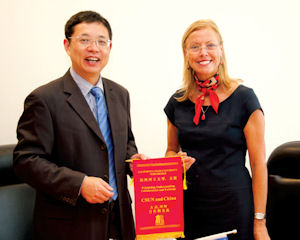California State University, Northridge recently announced a new exchange agreement with Central China Normal University (CCNU), the most recent addition to a growing roster of programs involving China offered by area universities. As an increasing number of students express interest in educational exchange on both sides of the Pacific, universities including Burbank-based Woodbury University’s School of Architecture, CSUN and Valencia’s CalArts have expanded their offerings in recent years. “This is very important and significant for us,” said CSUN president Dianne F. Harrison, in a statement about the new Memorandum of Understanding. “The agreement represents opportunities for our faculty and students for cultural exchanges where both universities benefit and learn from each other’s programs. I look forward to strengthening our relationships.” The new CSUN program is one of more than 40 arrangements, some formal and some informal, that the school has in place with Chinese universities. Future programs already are in the pipeline. “Students who are looking ahead see a lot of future in trade with China,” said former CSUN China Institute director Dr. Harold Geidt. “Students see that learning about the country is something they want to do.” While Northridge’s extensive and varied programs represent a long-standing interest in pairing with Chinese educational institutions, some other area schools have branched out into the country in recent years. Woodbury’s School of Architecture offers its students a summer program in China, including a five week fieldwork studio that pairs them with students at Nanjing’s Southeast University. The 14 to 18 students who participate in the exchange travel with professors from the school are teamed with Chinese students in groups of four to tackle ideas for solving urban architectural challenges. “I just felt that China is the future,” said Nick Roberts, an architecture professor who accompanied the first group in 2006. “We just have to be there. And with its 6,000 years of arts and culture that Westerners don’t always get to understand, I think it’s really important for students to experience.” Growing student interest American universities are seeing Chinese students flock to the U.S. as well. According to the Institute of International Education, 157,558 Chinese students studied at U.S. institutions in the 2010-11 academic year, and there was a 43 percent increase in the number of undergraduate students from China over the 2009-10 school year. While some students have branched into the arts categories, most remain overwhelmingly enrolled in science and business programs. CSUN began informal exchange programs for Chinese students in 1979, according to retired physics professor Dr. Paul Chow. Chow helped coordinate the first programs, which involved master’s students from Chinese schools coming to the Valley to teach freshman lab classes as teacher assistants. “We were the very first to take them. It was maybe three or four a year. The first were in physics. Then geology, then chemistry,” Chow said. Eventually undergraduates and graduate students began enrolling in the programs. Today, Northridge’s programs are supported by their China Institute, which coordinates the cultural and academic exchange of students. The Institute facilitates programs for the exchange of students, including scholarships and visiting scholar programs. Agreements such as the one that CSUN recently formalized allow for student exchange that keeps the cost of tuition and fees similar to what in-state students would pay at either school. Otherwise, international students pay much higher rates than local students. International students currently pay about $13,700 in tuition for an academic year compared to $7,002 for California students. But most involved say the costs are far outweighed by the benefits. Beyond the classroom Nearly all of the faculty involved in facilitating the exchange programs say that the learning done in the classroom is a small component of the educational exchange, as the experience is leading to a greater understanding of the country. For Robert Gustafson, an associate professor of media management who sits on the executive committee for the China Institute, the need for cultural and educational exchange became apparent when he travelled to the country in 2007 as a guest lecturer. “It was just absolutely eye opening,” he said. “You’re seeing the future.” For the architecture students at Woodbury, Roberts noted that even the approach to the discipline is different in China. “What is different is how they approach design, how they think about doing architecture. I can give a lecture and for some reason the Chinese students don’t get what I’m trying to say because it doesn’t jive with their experience, and the Chinese teachers have to step in to explain,” he said. Woodbury spokesperson Mimi Zeiger, said these cultural exchanges continue long after the travel time. “For faculty and students who travel to China, it has created a growing interest, and they bring that back to their work here,” she said.
